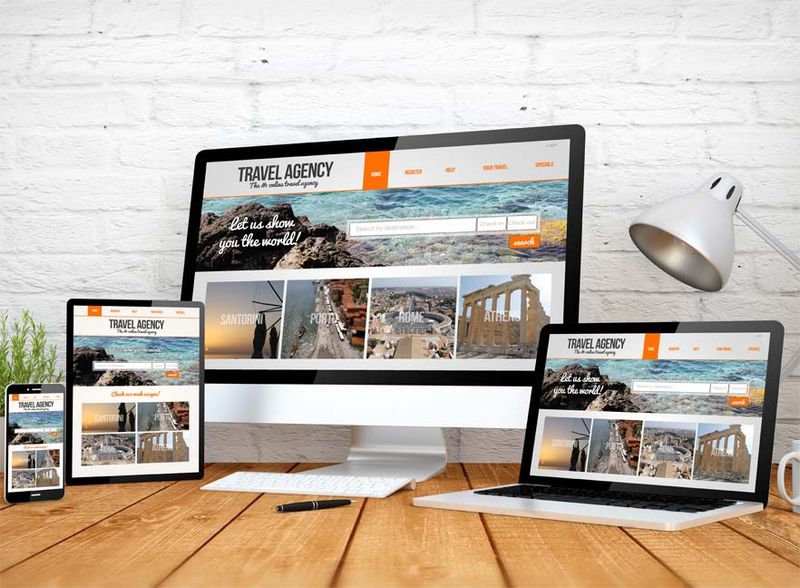Discover High Quality Web Design Near Me for Your Company Development
Discover High Quality Web Design Near Me for Your Company Development
Blog Article
Recognizing the Influence of Responsive Website Design on Mobile Web Traffic
In today's digital landscape, receptive website design has come to be pivotal in forming just how mobile traffic interacts with on the internet web content. As the number of mobile users remains to rise, the requirement for websites to flawlessly adapt to different screen sizes becomes significantly apparent. This versatility not only enhances user experience but likewise plays an essential role in minimizing and retaining site visitors bounce rates. Furthermore, online search engine prefer mobile-friendly websites, thus influencing search rankings and presence. What are the underlying strategies that contribute to efficient application, and exactly how do they better influence mobile interaction?
Importance of Mobile Compatibility
With the proliferation of tablet computers and smart devices, even more users are accessing the net through mobile devices than ever before. Mobile compatibility straight affects an internet site's ease of access, performance, and general efficiency, influencing customer involvement and complete satisfaction.
Integrating responsive website design is a vital approach to accomplishing mobile compatibility. This layout technique allows a website to instantly readjust its design and material based on the display size and positioning of the gadget being made use of (Fort Worth Web Development). This flexibility ensures that all individuals have a seamless experience, despite whether they are using a desktop computer, mobile phone, or tablet computer
Furthermore, mobile compatibility is carefully linked to search engine optimization (SEARCH ENGINE OPTIMIZATION) Services should prioritize mobile compatibility to continue to be affordable and ensure their digital visibility is easily accessible to the widest possible target market, inevitably driving development and engagement.
Enhancing Individual Experience
A seamless individual experience stands at the heart of effective web design, acting as a critical consider maintaining and engaging site visitors. In the context of receptive internet style, improving individual experience on mobile tools is important. As the number of mobile customers continues to increase, web sites need to adapt to different screen dimensions and positionings without compromising functionality or aesthetics. This flexibility makes certain that individuals can easily communicate and navigate with material, despite the device they utilize.
Crucial element of an improved mobile user experience consist of quickly loading times, user-friendly navigating, and available material. Fast packing times are important, as users are more likely to desert a website if it takes too long to load. Intuitive navigating ensures that users can find information quickly, while easily accessible material enables readability and communication without unneeded zooming or scrolling. Furthermore, touch-friendly user interfaces, which suit gestures such as swiping and touching, additionally enhance customer communication and contentment.
In addition, offering a regular visual and practical experience across tools develops depend on and integrity, motivating return visits. By focusing on these elements, responsive internet style not just satisfies mobile target markets but also promotes a favorable assumption of the brand name, ultimately enhancing general individual experience.
Boosting Mobile Interaction
To effectively improve mobile involvement, internet designers have to concentrate on developing engaging and interactive experiences that astound customers' interest. This entails utilizing receptive style techniques that adjust effortlessly to varying screen dimensions and orientations, ensuring that material is visually appealing and simple to navigate on mobile phones. Focusing on fast loading times is vital, as customers are most likely to abandon websites that are slow or unresponsive. Executing functions such as touch-friendly navigating, succinct material, and intuitive interface can dramatically enhance customer communication and satisfaction.

Moreover, leveraging personalization methods, such as tailored content referrals based upon customer behavior and preferences, can develop more purposeful communications and motivate repeat check outs. By concentrating on these elements, internet developers can significantly boost mobile engagement, guaranteeing that customers remain engaged and spent in the content, ultimately driving higher retention rates and individual contentment.
Search Engine Optimization Advantages of Responsive Design
As internet developers enhance mobile interaction with receptive methods, one more significant benefit emerges in the realm of search engine optimization (SEO) Receptive website design (RWD) plays a vital function in enhancing a site's exposure and position on search engines. By making certain a seamless customer experience throughout devices, receptive style minimizes bounce rates, an important statistics that online search engine think about when figuring out site significance and top quality.
Google, which commands a substantial share of the search market, supporters for receptive layout as the sector standard. A single URL structure, assisted in by RWD, simplifies creeping and indexing procedures for internet search engine crawlers. This effectiveness enhances a website's accessibility and makes it simpler for online search engine to recognize and place material properly.
Moreover, responsive layout enhances filling times, one more aspect greatly weighted in Google's algorithms. A faster, a lot more effective website enhances customer satisfaction, resulting in longer page sees and greater engagement degrees, which positively impact SEO rankings. moved here Furthermore, RWD supports the implementation of enhanced metadata and tags, guaranteeing that web content is appropriately tailored for mobile and desktop computer customers alike.
Methods for Efficient Application
When applying responsive web style, recognizing crucial techniques is crucial for success. This approach also helps improve web content, concentrating on vital elements that enhance individual experience.
Second, utilize adaptable grid formats and scalable pictures. An adaptable grid makes sure that the site's layout adjusts effortlessly across different display sizes. Making use of scalable photos that adapt based on resolution avoids distortion and maintains photo top quality, enhancing the general aesthetic.
Third, maximize loading times. Use methods such as compressing photos and minifying CSS and JavaScript submits to guarantee fast page loads. Rate is essential for preserving mobile customers that might abandon slow-loading websites.

Last but not least, utilize analytics to check performance and individual behavior. Analytics supply insights into exactly how customers interact with the website, directing more optimization initiatives to fulfill advancing demands. By following these approaches, organizations can efficiently apply receptive website design, optimizing their mobile traffic capacity.
Verdict
Responsive internet design plays an essential role in enhancing mobile web traffic by ensuring sites are accessible across different tools. By readjusting layouts for different screen dimensions, it substantially improves individual experience, minimizes bounce prices, and boosts visit period. Mobile-friendly websites acquire top priority in online search engine positions, driving more traffic. This adaptability attends to the growing variety of mobile customers, promotes involvement through user-friendly navigating, and makes sure quickly loading times, which are necessary for keeping visitors and boosting overall digital presence.
In the context of responsive internet design, improving customer experience on mobile gadgets is important.Trick aspects of an enhanced mobile customer experience include quickly loading times, user-friendly navigation, and available material.To properly increase mobile interaction, internet designers should focus on creating interactive and compelling experiences that astound customers' attention. Executing features such as touch-friendly navigation, concise web content, and instinctive individual interfaces can significantly improve customer interaction and satisfaction.
Furthermore, RWD supports the application of enhanced metadata and tags, guaranteeing that content is suitably customized for mobile and desktop computer users alike.
Report this page